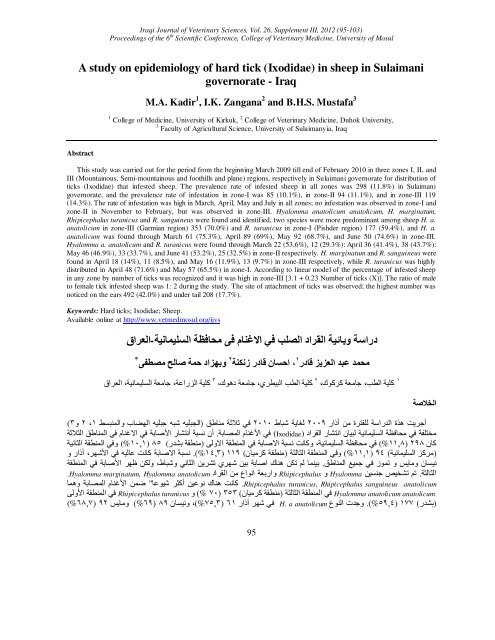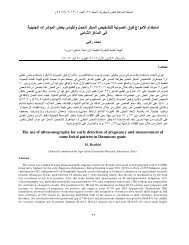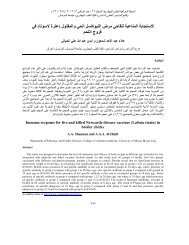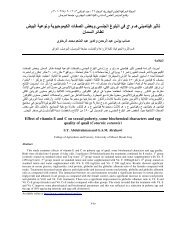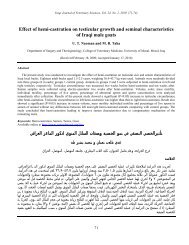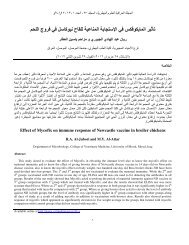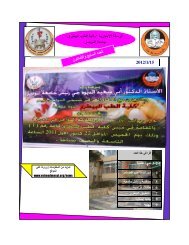fulltext (pdf) - College of Veterinary Medicine, University of Mosul, Iraq
fulltext (pdf) - College of Veterinary Medicine, University of Mosul, Iraq
fulltext (pdf) - College of Veterinary Medicine, University of Mosul, Iraq
You also want an ePaper? Increase the reach of your titles
YUMPU automatically turns print PDFs into web optimized ePapers that Google loves.
<strong>Iraq</strong>i Journal <strong>of</strong> <strong>Veterinary</strong> Sciences, Vol. 26, Supplement III, 2012 (95-103)<br />
Proceedings <strong>of</strong> the 6 th Scientific Conference, <strong>College</strong> <strong>of</strong> <strong>Veterinary</strong> <strong>Medicine</strong>, <strong>University</strong> <strong>of</strong> <strong>Mosul</strong><br />
A study on epidemiology <strong>of</strong> hard tick (Ixodidae) in sheep in Sulaimani<br />
governorate - <strong>Iraq</strong><br />
M.A. Kadir 1 , I.K. Zangana 2 and B.H.S. Mustafa 3<br />
1 <strong>College</strong> <strong>of</strong> <strong>Medicine</strong>, <strong>University</strong> <strong>of</strong> Kirkuk, 2 <strong>College</strong> <strong>of</strong> <strong>Veterinary</strong> <strong>Medicine</strong>, Duhok <strong>University</strong>,<br />
3 Faculty <strong>of</strong> Agricultural Science, <strong>University</strong> <strong>of</strong> Sulaimanyia, <strong>Iraq</strong><br />
Abstract<br />
This study was carried out for the period from the beginning March 2009 till end <strong>of</strong> February 2010 in three zones I, II, and<br />
III (Mountainous, Semi-mountainous and foothills and plane) regions, respectively in Sulaimani governorate for distribution <strong>of</strong><br />
ticks (Ixodidae) that infested sheep. The prevalence rate <strong>of</strong> infested sheep in all zones was 298 (11.8%) in Sulaimani<br />
governorate, and the prevalence rate <strong>of</strong> infestation in zone-I was 85 (10.1%), in zone-II 94 (11.1%), and in zone-III 119<br />
(14.3%). The rate <strong>of</strong> infestation was high in March, April, May and July in all zones; no infestation was observed in zone-I and<br />
zone-II in November to February, but was observed in zone-III. Hyalomma anatolicum anatolicum, H. marginatum,<br />
Rhipicephalus turanicus and R. sanguineus were found and identified, two species were more predominant among sheep H. a.<br />
anatolicum in zone-III (Garmian region) 353 (70.0%) and R. turanicus in zone-I (Pishder region) 177 (59.4%), and H. a.<br />
anatolicum was found through March 61 (75.3%), April 89 (69%), May 92 (68.7%), and June 50 (74.6%) in zone-III.<br />
Hyalomma a. anatolicum and R. turanicus were found through March 22 (53.6%), 12 (29.3%): April 36 (41.4%), 38 (43.7%):<br />
May 46 (46.9%), 33 (33.7%), and June 41 (53.2%), 25 (32.5%) in zone-II respectively. H. marginatum and R. sanguineus were<br />
found in April 18 (14%), 11 (8.5%), and May 16 (11.9%), 13 (9.7%) in zone-III respectively, while R. turanicus was highly<br />
distributed in April 48 (71.6%) and May 57 (65.5%) in zone-I. According to linear model <strong>of</strong> the percentage <strong>of</strong> infested sheep<br />
in any zone by number <strong>of</strong> ticks was recognized and it was high in zone-III [3.1 + 0.23 Number <strong>of</strong> ticks (X)]. The ratio <strong>of</strong> male<br />
to female tick infested sheep was 1: 2 during the study. The site <strong>of</strong> attachment <strong>of</strong> ticks was observed; the highest number was<br />
noticed on the ears 492 (42.0%) and under tail 208 (17.7%).<br />
Keywords: Hard ticks; Ixodidae; Sheep.<br />
Available online at http://www.vetmedmosul.org/ijvs<br />
دراسة وبائية القراد الصلب في االغنام فى محافظة السليمانية-العراق<br />
٣<br />
٢<br />
١<br />
محمد عبد العزيز قادر ، احسان قادر زنكنة وبھزاد حمة صالح مصطفى<br />
٣<br />
٢<br />
كلية الطب، جامعة كركوك،<br />
كلية الطب البيطري، جامعة دھوك،<br />
كلية الزراعة، جامعة السليمانية، العراق<br />
١<br />
الخالصة<br />
و٣)<br />
في ثالثة مناطق (الجبليه شبه جبليه الھضاب والمنبسط لغاية شباط أجريت ھذة الدراسة للفترة من أذار في األغنام المصابة. أن نسبة أنتشار األصابة في االغنام في المناطق الثالثة<br />
مختلفة في محافظة السليمانية لبيان انتشار القراد وفي المنطقة الثانية<br />
في محافظة السليمانية، وكانت نسبة االصابة في المنطقة االولى (منطقة بشدر)<br />
نسبة االصابة كانت عاليه في األشھر، أذار و<br />
وفي المنطقة الثالثة (منطقة كرميان)<br />
(مركز السليمانية)<br />
نيسان ومايس و تموز في جميع المناطق. بينما لم تكن ھناك اصابة بين شھري تشرين الثاني وشباط، ولكن ظھر األصابة في المنطقة<br />
و<br />
الثالثة. تم تشخيص جنسين كانت ھناك نوعين أكثر شيوعا" ضمن األغنام المصابة وھما<br />
في المنطقة األولى<br />
في المنطقة الثالثة (منطقة كرميان) ٣٥٣<br />
ومايس<br />
في شھر أذار ٦١<br />
(بشدر)<br />
٢ ،١<br />
(%١٠,١) ٨٥<br />
.(%١٤,٣) ١١٩<br />
٢٠١٠ ٢٠٠٩<br />
(Ixodidae)<br />
كان (%١١,٨) ٢٩٨<br />
(%١١,١) ٩٤<br />
.Hyalomma marginatum, Hyalomma anatolicum واربعة انواع من القراد Rhipicephalus Hyalomma<br />
.Rhipicephalus turanicus, Rhipicephalus sanguineus anatolicum<br />
٧٠) (% و Rhipicephalus turanicus<br />
Hyalomma anatolicum anatolicum<br />
٩٢ (%٦٨,٧)<br />
،(%٧٥,٣) ونيسان (%٦٩) ٨٩ .(%٥٩,٤) ١٧٧ وجدت النوع H. a anatolicum<br />
95
<strong>Iraq</strong>i Journal <strong>of</strong> <strong>Veterinary</strong> Sciences, Vol. 26, Supplement III, 2012 (95-103)<br />
Proceedings <strong>of</strong> the 6 th Scientific Conference, <strong>College</strong> <strong>of</strong> <strong>Veterinary</strong> <strong>Medicine</strong>, <strong>University</strong> <strong>of</strong> <strong>Mosul</strong><br />
في شھر نيسان<br />
و<br />
بالتعاقب في المنطقة الثالثة (كرميان). وجدت ايضا"<br />
وتموز<br />
كانت عالية<br />
و بالتعاقب في المنطقة الثانية.<br />
و وفي شھر مايس<br />
في المنطقة األولى. بطريقة المعادلة الخطية، النسبة المئوية الألغنام<br />
وفي مايس<br />
األنتشار في نيسان<br />
عدد القراد<br />
المصابة في أي منطقة من المناطق الثالثة مقارنة" مع عدد القراد كانت مميزة وكان عاليا" في المنطقة الثالثة<br />
ولوحظ بان نسبة األناث الى الذكور كان ٢:١. تم دراسة موقع وجود القراد والتصاقة بأ جسا م األغنام، و اعلى نسبة للقراد كانت في<br />
وتحت الذيل ٢٠٨<br />
١٨<br />
R. sanguineus<br />
بينما R. turanicus<br />
٠,٢٣ + ٣,١]<br />
بان H. marginatum<br />
(%٩,٧) ١٣ (%١١,٩) ١٦<br />
(%٦٥,٥) ٥٧<br />
.(%١٧,٧)<br />
(%٧٤,٦) ٥٠<br />
(%٨,٥) ١١ (%٤)<br />
(%٧١,٦) ٤٨<br />
.[(X)<br />
األذن (%٤٢) ٤٩٢<br />
Introduction<br />
There are two well established families <strong>of</strong> tick, the<br />
Ixodidae (hard tick), and Argasidae (s<strong>of</strong>t tick), both are<br />
important vectors <strong>of</strong> disease-causing agents to human and<br />
animals throughout the world (1). Tick is obligatory blood<br />
sucking arachnid arthropods; infesting mammals, birds,<br />
reptiles and amphibian. They act as vectors <strong>of</strong> diseases,<br />
causing anemia, dermatitis, paralysis, otoacariasis as well<br />
as loss <strong>of</strong> production (2). These parasites generate direct<br />
effect in cattle on terms <strong>of</strong> milk production and gain weight<br />
reduction (3). In Ixodidae, the hard ticks, there are several<br />
genera and species. Those <strong>of</strong> veterinary importance are in<br />
the genera Boophilus, Rhipicephalus, Amblyomma,<br />
Haemaphysalis, Hyalomma, Dermacentor and Ixodes (4).<br />
Some species <strong>of</strong> hard ticks are important vector <strong>of</strong><br />
Nairovirus (Crimean Congo Hemorrhagic Fever),<br />
theileriosis, babesiosis and anplasmosis (5). Usually<br />
associated with tick <strong>of</strong> genera Hyalomma spp. and widely<br />
prevalent within those handling field tick, also infestation<br />
with ticks has a variety <strong>of</strong> direct and indirect effects on their<br />
host through blood loss, skin inflammation (Pruritus), hair<br />
and wool loss, toxic and allergic reaction (6).<br />
The present study was planned to show the prevalence<br />
<strong>of</strong> hard ticks in Sulaimania governorate.<br />
Material and methods<br />
A survey study was carried out to show the distribution<br />
<strong>of</strong> ticks in Sulaimani governorate. Sulaimani governorate is<br />
located at north east <strong>of</strong> <strong>Iraq</strong>. The international border with<br />
Iran represents the eastern boundary <strong>of</strong> the governorate. It<br />
is bounded in north and north-west by Erbil governorate,<br />
west by Kirkuk governorate and Salahaddin governorate,<br />
south and southwest by Diala. Sulaimani governorate was<br />
divided in to three different zones, depended on topography<br />
and climate factors for study on the distribution <strong>of</strong><br />
Ixodidae. The three zones were; Zone I, Mountainous areas;<br />
Zone II, Semi-mountainous areas and Zone III, foothills<br />
and plane areas.<br />
Tick collection and identification<br />
Ticks were collected from 2025 local breed sheep from<br />
various flock, in three different zones (Zone-I: 840, Zone-<br />
II: 850, and Zone-III: 835) through periods from the<br />
beginning <strong>of</strong> March 2009 till the end <strong>of</strong> February 2010<br />
(Table 1). Ticks were counted and identified, based on<br />
morphological features according to (7 and 8) using a<br />
dissecting microscope (Dissecting microscope, Motic-<br />
Education, China.), magnifying-hand lens and the binocular<br />
microscope (Altay, Biovision-103B, Chin).<br />
A total number <strong>of</strong> 1171 ticks were collected form the<br />
three different zones (Zone-I: 298, Zone-II: 369, and Zone-<br />
III: 504) as shown in (Table 1).<br />
Table (1): Number <strong>of</strong> sheep examined and tick collected<br />
from sheep in different zones.<br />
Zone<br />
Zone-I<br />
Zone-II<br />
Zone-III<br />
Total<br />
Location<br />
Peshder region<br />
(Qaladaza- Sangasar-<br />
Rania-Betwata-<br />
Bingird)<br />
Sulaimani region<br />
(Qaradakh-Mawat-<br />
Penjwen-Halabja-<br />
Chamchamal, Bazyan)<br />
Garmian region<br />
(Kalar-Kifri- Maydan-<br />
Darbandekhan,<br />
Sangaw)<br />
N0. <strong>of</strong><br />
sheep<br />
examined<br />
840<br />
850<br />
835<br />
2525<br />
NO. <strong>of</strong><br />
tick<br />
collected<br />
298<br />
369<br />
504<br />
1171<br />
Statistical analysis: Statistical analysis was conducted<br />
using SPSS from windows (Version 7). Chi-square and t-<br />
test were done to find significant differences between<br />
zones, seasons, species and sex (9).<br />
Results<br />
Tick speices and distribution<br />
In this study two genera <strong>of</strong> hard ticks, Hyalomma and<br />
Rhipicephalus were observed and for each genus, two<br />
species (Hyalomma anatolicum anatolicum, H.<br />
marginatum) and (R. turanicus, R. sanguineus) were<br />
identified according to morphological features.<br />
96
<strong>Iraq</strong>i Journal <strong>of</strong> <strong>Veterinary</strong> Sciences, Vol. 26, Supplement III, 2012 (95-103)<br />
Proceedings <strong>of</strong> the 6 th Scientific Conference, <strong>College</strong> <strong>of</strong> <strong>Veterinary</strong> <strong>Medicine</strong>, <strong>University</strong> <strong>of</strong> <strong>Mosul</strong><br />
Table (2) shows four species <strong>of</strong> ticks which were<br />
identified from the genera Hyalomma (H. a anatolicum, H.<br />
marginatum), the highest number and percentage species<br />
were H. a anatolicum 608 (51.9%), H. marginatum 122<br />
(10.4%), and genera Rhipicephalus, R. sanguineus 90<br />
(7.7%) and R. turanicus 351 (30%) during the study year.<br />
Table (2): Number and percentage <strong>of</strong> different tick species identified in 3 zones in Suliamani governorate.<br />
Zones<br />
Zone- 1<br />
Zone- II<br />
Zone-III<br />
Total<br />
No. & (%)<br />
R. sanguineus<br />
23<br />
7.7<br />
20<br />
5.4<br />
47<br />
9.3<br />
90<br />
7.7<br />
Genus: Rhipicephalus<br />
No. &(%)<br />
R. turanicus'<br />
177<br />
59.4<br />
124<br />
33.6<br />
50<br />
10.0<br />
351<br />
30.0<br />
No. & (%)<br />
H. a anatolicum<br />
64<br />
21.5<br />
191<br />
51.8<br />
353<br />
70.0<br />
608<br />
51.9<br />
Genus: Hyalomma<br />
No. & (%)<br />
H. marginatum<br />
34<br />
11.4<br />
34<br />
9.2<br />
54<br />
10.7<br />
122<br />
10.4<br />
Total<br />
No.<br />
Ticks<br />
298<br />
369<br />
504<br />
1171<br />
The data in table (3) show that the distribution <strong>of</strong> tick<br />
species during different months <strong>of</strong> the study according to<br />
Chi square test showed fluctuation in the occurrences. The<br />
number <strong>of</strong> H anatolicum anatolicum was highly distributed<br />
in March, April, May, and June 61 (75.3%), 89 (69%), 92<br />
(68.7%), and 50 (74.6%), respectively in zone-III and<br />
Rhipicephalus sanguineus was highly distributed in April,<br />
May, and June 11 (8.5%), 13 (9.7%), and 10 (14.9%)<br />
respectively in zone-III in comparison with other zones,<br />
while the number <strong>of</strong> Hyalomma marginatum was highly<br />
distributed in April and May 18 (14%) and 16 (11.9%) in<br />
zone-III comparing to other zones and the number <strong>of</strong><br />
Rhipicephalus turanicus was highly distributed in zone-I in<br />
March, April and May 23 (71.8%), 48 (71.6%), and 57<br />
(65.5%) respectively.<br />
The distribution <strong>of</strong> ticks according to seasons (figure 1),<br />
showed that it was highest in spring, followed by summer,<br />
then the number <strong>of</strong> ticks was decreased in both autumn and<br />
winter seasons.<br />
The data in table (4) show the mean value (Mean ± SE)<br />
<strong>of</strong> distribution <strong>of</strong> different species <strong>of</strong> tick: H. anatolicum<br />
anatolicum was highest in zone-III 35.3 ± 18.4 followed by<br />
zone-II 23.9 ± 9.1 and zone-I 8 ± 2.5 respectively, while in<br />
Hyalomma marginatum the difference did not vary<br />
significantly among the zones, Rhipicephalus sanguineus<br />
was highest in zone-III 6.7 ± 2.8 in comparism to zone-I,<br />
2.9 ± 1.2 and 2.9 ± 1.1 in zone-II, while the species<br />
Rhipicephalus turanicus distribution was highest 29.5 ± 2.9<br />
in zone-I followed by zone-II 15.5 ± 7.6 and zone-III 6.3 ±<br />
3.5.<br />
The results in table (5) show the distribution <strong>of</strong> tick<br />
sexes. It was found the number <strong>of</strong> infested female tick was<br />
greater than the male and the ratio <strong>of</strong> male to female was<br />
1:2.4.<br />
Figure (1): Distribution <strong>of</strong> tick according to seasons.<br />
Table (6) show that the total number <strong>of</strong> adult tick was<br />
mostly engorged female for both genera 554 (47.3%)<br />
followed by non-engorged females 263 (22.5%) and adult<br />
male 354 (30.2%). H. anatolicum anatolicum gave the<br />
highest number <strong>of</strong> engorged females 319 (57.6%) and male<br />
177 (50%), followed by Rhipicephalus turanicus 147<br />
(26.5%) engorged females and 110 (31.1%) adult males,<br />
while H. marginatum females were 49 (8.9%) and males 40<br />
(11.3%) and R. sanguineus females were 39 (7.0%) and<br />
males was 27 (7.6%), respectively. No nymph and larvae<br />
were found.<br />
The results in table (7) show the sites <strong>of</strong> attacks <strong>of</strong> the<br />
tick on the body <strong>of</strong> infested sheep. The highest number 492<br />
(42.0%) <strong>of</strong> ticks was on ear, followed by under tail 208<br />
(17.7%), udder 139 (11.9%), between thighs 112 (9.6%),<br />
under axilla 105 (9.0%) and testes 95 (8.1%).. The lowest<br />
number was on eyelid 20 (1.7%).<br />
97
<strong>Iraq</strong>i Journal <strong>of</strong> <strong>Veterinary</strong> Sciences, Vol. 26, Supplement III, 2012 (95-103)<br />
Proceedings <strong>of</strong> the 6 th Scientific Conference, <strong>College</strong> <strong>of</strong> <strong>Veterinary</strong> <strong>Medicine</strong>, <strong>University</strong> <strong>of</strong> <strong>Mosul</strong><br />
Table (3): Distribution <strong>of</strong> tick species according to months in different zones.<br />
Zone-I Zone-II Zone-III<br />
Months<br />
R. spp<br />
H. spp<br />
R. spp H. spp R..spp H. spp<br />
(No.& %) (No.& %) (No.& %) (No.& %) (No.& %) (No.& %)<br />
R. s* R. t* H a.a* H m* R. s R. t H a.a H. m R. s R. t H. a H. m<br />
March<br />
2 23 5 2 3 12 22 4 4 10 61 6<br />
6.3 71.8 15.6 6.3 7.3 29.3 53.6 9.8 4.9 12.4 75.3 7.4<br />
April<br />
3 48 9 7 6 38 36 7 11 11 89 18<br />
4.5 71.6 13.4 10.5 6.9 43.7 41.4 8 8.5 8.5 69 14<br />
May<br />
6 57 15 9 4 33 46 15 13 13 92 16<br />
6.9 65.5 17.2 10.4 4.1 33.7 46.9 15.3 9.7 9.7 68.7 11.9<br />
Spring//Total 11 128 29 18 13 83 104 26 28 34 242 40<br />
June<br />
7 24 15 9 4 25 41 7 10 3 50 4<br />
12.7 43.6 27.3 16.4 5.2 32.5 53.2 9.1 14.9 4.5 74.6 6<br />
July<br />
2 16 5 6 1 12 32 1 5 3 18 6<br />
6.9 55.2 17.2 20.7 2.2 26 69.6 2.2 15.6 9.4 56.3 18.7<br />
August<br />
1 9 5 1 1 2 8 0 1 2 14 4<br />
6.2 56.3 31.3 6.2 9.1 18.2 72.8 0.0 4.8 9.5 66.7 19<br />
Summer/Total 10 49 25 16 6 39 81 8 16 8 82 14<br />
September<br />
1<br />
8<br />
1 1 4<br />
1 4<br />
0<br />
0<br />
0 0<br />
11.1<br />
88.9<br />
16.7 16.7 66.6<br />
20 80<br />
0<br />
October<br />
1<br />
2<br />
1 2<br />
3<br />
0<br />
0 0<br />
0 0 0<br />
33.3<br />
66.7<br />
33.3 66.7<br />
100<br />
0<br />
November 0 0 0 0 0 0 0 0 0 0<br />
1<br />
100<br />
0<br />
Autumn/Total 2 0 10 0 1 2 6 0 0 1 8 0<br />
December 0 0 0 0 0 0 0 0 0 0 0 0<br />
January 0 0 0 0 0 0 0 0 0 0 0 0<br />
February 0 0 0 0 0 0 0 0<br />
3 7 21<br />
9.7 22.6 67.7<br />
0<br />
Winter/Total 0 0 0 0 0 0 0 0 3 7 21 0<br />
Total Number 23 177 64 34 20 124 191 34 47 50 353 54<br />
Total ticks 298 369 504<br />
Total Number 1171<br />
χ²cal P < 0.01 281.6 **<br />
R. s. = Rhipicephalus sanguineus; R. t. = Rhipicephalus turanicus; H. a. a. = Hyalomma anatolicum anatolicum; H. m. =<br />
Hyalomma marginatum. *
<strong>Iraq</strong>i Journal <strong>of</strong> <strong>Veterinary</strong> Sciences, Vol. 26, Supplement III, 2012 (95-103)<br />
Proceedings <strong>of</strong> the 6 th Scientific Conference, <strong>College</strong> <strong>of</strong> <strong>Veterinary</strong> <strong>Medicine</strong>, <strong>University</strong> <strong>of</strong> <strong>Mosul</strong><br />
statistically there was not significant difference between<br />
zones.<br />
The rate <strong>of</strong> infestation was higher in May 22.0, 23.3<br />
and 36.0% in the three zones 1,11, 111 respectively than<br />
other months <strong>of</strong> the study, and there was no infested sheep<br />
observed in zone-I and zone-II from November to February,<br />
while in zone-III the rate <strong>of</strong> infestation was 2.0, 0%, 0.0 and<br />
15.0%, in December, January and February respectively.<br />
The data in table (9) show that, the distribution <strong>of</strong> tick's<br />
species were not differed significantly among the zone-I,<br />
zone-II, and zone-III (298, 396, and 504), respectively. The<br />
higher number <strong>of</strong> ticks collected from sheep in April, May<br />
and June 32, 67, and 87 in zone-I, 41, 87, and 98 in zone-II<br />
and 81, 129, and 134 in zone-III respectively, but the<br />
number was low in July till October 29, 16, 9, and 3 in<br />
zone-I, 46, 11, 6, and 3 in zone-II and 32, 21, 5, and 3 in<br />
zone-III respectively, and no tick was collected in<br />
November till February in zone-I and zone-II, except in<br />
zone III only 31 ticks were collected in February.<br />
The percentage <strong>of</strong> infested sheep in any zone by number<br />
<strong>of</strong> ticks was recognized from the linear model in (Figure 4;<br />
A, B and C). There were difference infestation rates in<br />
different zones, the highest infestation was recorded in zone<br />
III which was (3.1) followed by zone II which was (2.3)<br />
and the lowest rate (2.0) recorded in zone I. The linear<br />
model in zone-I, II and III showed that the r² were highly<br />
significant, and the number <strong>of</strong> ticks was an indicator for<br />
estimation <strong>of</strong> the infested percentage. Hence each tick<br />
infestation was increased in rate 0.25 in zone-I, and in the<br />
zone-III, each tick showed that the increasing <strong>of</strong> infested<br />
rate by 0.23, but the influence in zone-II showed that the<br />
tick infestation increased in rate 0.22.<br />
Table (5): Distribution and ratio <strong>of</strong> ticks according to sex.<br />
Specimens <strong>of</strong> adult ticks<br />
Rhipicephalus sanguineus<br />
Rhipicephalus turanicus<br />
Hyalomma anatolicum anatolicum<br />
Hyalomma marginatum<br />
Total<br />
N0<br />
%<br />
N0<br />
%<br />
N0<br />
%<br />
No<br />
%<br />
N0<br />
%<br />
Male<br />
No.& %<br />
27<br />
(30.0)<br />
110<br />
(31.3)<br />
177<br />
(29.1)<br />
40<br />
(32.8)<br />
354<br />
29.4<br />
Female<br />
No&.%<br />
63<br />
(70.0)<br />
241<br />
(68.7)<br />
431<br />
(70.9)<br />
82<br />
(67.2)<br />
817<br />
70.6<br />
Total<br />
No.& % ♂/♀<br />
90<br />
(7.7) 1:2<br />
351<br />
(29.9) 1:2<br />
608<br />
(51.9) 1:2<br />
122<br />
(10.5) 1:2<br />
1171 1:2<br />
Table (6): Number and percentage <strong>of</strong> tick stages on the infested sheep in different flocks.<br />
Tick species<br />
Tick stage Rhipicephalus spp. No.& %<br />
Hyalomma spp No& %<br />
R. s<br />
R. t<br />
H a. a<br />
H. m<br />
-Adult female<br />
39<br />
147<br />
319<br />
49<br />
- Engorged female<br />
(7.0)<br />
(26.5) (57.6)<br />
(8.9)<br />
Total Ticks<br />
No.& %<br />
554<br />
(47.3)<br />
- Non-engorged Female<br />
24<br />
(9.1)<br />
94<br />
(35.7)<br />
112<br />
(42.6)<br />
33<br />
(12.5)<br />
263<br />
(22.5)<br />
Total N0.<br />
Adult male<br />
Nymph<br />
Larvae<br />
Total<br />
63<br />
27<br />
(7.6)<br />
0<br />
0<br />
441<br />
241<br />
110<br />
(31.1)<br />
431<br />
177<br />
(50)<br />
0<br />
0<br />
730<br />
82<br />
40<br />
(11.3)<br />
817<br />
354<br />
(30.2)<br />
0<br />
0<br />
1171<br />
99
<strong>Iraq</strong>i Journal <strong>of</strong> <strong>Veterinary</strong> Sciences, Vol. 26, Supplement III, 2012 (95-103)<br />
Proceedings <strong>of</strong> the 6 th Scientific Conference, <strong>College</strong> <strong>of</strong> <strong>Veterinary</strong> <strong>Medicine</strong>, <strong>University</strong> <strong>of</strong> <strong>Mosul</strong><br />
Table (7): Number and percentage <strong>of</strong> ticks on body site <strong>of</strong> sheep.<br />
Site <strong>of</strong> body<br />
Ear<br />
Eyelid<br />
Under axilla<br />
Between<br />
Thigh<br />
Udder<br />
Testes<br />
Under tail<br />
Total<br />
Rhipicephalus. spp<br />
R. s<br />
R. t<br />
No.and % No.and %<br />
52<br />
159<br />
(10.6)<br />
(32.3)<br />
1<br />
(5.0)<br />
8<br />
(7.6)<br />
6<br />
(5.4)<br />
9<br />
(6.5)<br />
7<br />
(7.4)<br />
7<br />
(3.4)<br />
90<br />
(7.7)<br />
8<br />
(40.0)<br />
30<br />
(28.6)<br />
35<br />
(31.2)<br />
37<br />
(26.6)<br />
29<br />
(30.5)<br />
53<br />
(25.5)<br />
351<br />
(30.0)<br />
Hyalomma. Spp<br />
H. a.a<br />
H. m<br />
No.and % No.and %<br />
248<br />
33<br />
(50.4)<br />
(6.7)<br />
10<br />
(50.5)<br />
47<br />
(44.8)<br />
55<br />
(49.1)<br />
82<br />
(59.0)<br />
56<br />
(58.9)<br />
110<br />
(52.9)<br />
608<br />
(51.9)<br />
1<br />
(5.0)<br />
Total ticks<br />
No. and %<br />
492<br />
(42.0)<br />
20<br />
(1.7)<br />
20<br />
(19.0)<br />
105<br />
(9.0)<br />
16<br />
112<br />
(14.3)<br />
(9.6)<br />
11<br />
139<br />
(7.9)<br />
(11.9)<br />
3<br />
95<br />
(3.2)<br />
(8.1)<br />
38<br />
208<br />
(18.2)<br />
(17.7)<br />
122<br />
(10.4) 1171<br />
Table (8): Number and percentage <strong>of</strong> infested sheep with hard ticks (Ixodidae) related to monthly occurrence in different zones<br />
in Suliamani governorate.<br />
Months<br />
No.<br />
sheep<br />
examined<br />
Zone-I Zone-II Zone-III<br />
No. Sheep No. No. Sheep No. No.<br />
sheep infested sheep sheep infested sheep sheep<br />
infested % examined infested % examined infested<br />
Sheep<br />
infested<br />
%<br />
March 85 9 10.6 90 11 12.2 85 21 24.7<br />
April 110 18 16.4 95 19 20.0 100 27 27.0<br />
May 95 21 22.0 90 21 23.3 75 27 36.0<br />
June 90 16 17.8 90 18 20.0 60 15 25.0<br />
July 65 9 13.8 90 13 14.4 80 8 10.0<br />
August 70 6 8.6 60 6 10.0 75 6 8.0<br />
September 70 4 5.7 80 4 5.0 60 3 5.0<br />
October 50 2 4.0 40 2 5.0 50 2 4.0<br />
November 50 0 0 55 0 0 50 1 2.0<br />
December 50 0 0 60 0 0 60 0 0<br />
January 55 0 0 50 0 0 75 0 0<br />
February 50 0 0 50 0 0 60 9 15.0<br />
Total 840 85 10.1 850 94 11.1 830 119 14.3<br />
M ± SE 12.36 ± 2.2 a 13.73 ± 2.46 a 15.67± 3.7 a<br />
Total Number sheep 2525<br />
Total number <strong>of</strong> infested sheep 298<br />
Numbers with the same letter within a column are not significantly different from each other according to Duncan's multiple<br />
range tests (P ≤ 0.05).<br />
The data in table (10) shows the total number <strong>of</strong> tick<br />
which infested per sheep was 3.5, 3.9, and 4.2 in zone-I,II,<br />
and III, respectively during the study and the highest<br />
number <strong>of</strong> ticks infested per sheep was in May 4.1, 4.7 and<br />
5.0 in all zones respectively, and the lowest number was<br />
detected in October and absent in November till February in<br />
100
<strong>Iraq</strong>i Journal <strong>of</strong> <strong>Veterinary</strong> Sciences, Vol. 26, Supplement III, 2012 (95-103)<br />
Proceedings <strong>of</strong> the 6 th Scientific Conference, <strong>College</strong> <strong>of</strong> <strong>Veterinary</strong> <strong>Medicine</strong>, <strong>University</strong> <strong>of</strong> <strong>Mosul</strong><br />
all zones, except in zone-III, the number <strong>of</strong> tick per infested<br />
sheep was one in November and 3.4 in February.<br />
Table (9): Number <strong>of</strong> ticks collected from sheep from<br />
different zones.<br />
Zone-I Zone-II Zone-III<br />
Months<br />
No. <strong>of</strong> tick No. <strong>of</strong> tick No. <strong>of</strong> tick<br />
collected collected collected<br />
March 32 41 81<br />
April 67 87 129<br />
May 87 98 134<br />
June 55 77 67<br />
July 29 46 32<br />
August 16 11 21<br />
September 9 6 5<br />
October 3 3 3<br />
November 0 0 1<br />
December 0 0 0<br />
January 0 0 0<br />
February 0 0 31<br />
Total 298 369 504<br />
M ± SE<br />
37.25a± 46.12a± 50.4a±<br />
10.51 13.39 15.88<br />
Overall<br />
ticks<br />
1171<br />
Numbers with the same letter within a raw are not<br />
significantly differed from each other according to<br />
Duncan's multiple range tests (P ≤ 0.05).<br />
Table (10): Ratio <strong>of</strong> hard ticks per sheep in different zones<br />
in Suliamani Governorate.<br />
Zone-I Zone-II Zone-III<br />
Months<br />
No. Tick / No. Tick / No. Tick /<br />
infested infested infested<br />
sheep sheep sheep<br />
March 3.6 3.7 3.9<br />
April 3.7 4.6 4.8<br />
May 4.1 4.7 5.0<br />
June 3.4 4.2 4.5<br />
July 3.2 3.5 4<br />
August 2.7 1.8 3.5<br />
September 2.3 1.5 1.7<br />
October 1.5 1.5 1.5<br />
November 0 0 1<br />
December 0 0 0<br />
January 0 0 0<br />
February 0 0 3.4<br />
Total 3.5 3.9 4.2<br />
Infested sheep<br />
2 0<br />
1 5<br />
1 0<br />
5<br />
0<br />
- 1 0 0 1 0 2 0 3 0 4 0 5 0 6 0 7 0 8 0 9 0<br />
N u m b e r o f tic ks<br />
A-zone-1: Infested sheep (Y) =2.0 + 0.25 (X) (X=Number<br />
<strong>of</strong> ticks). R² = 0.91*.<br />
Infested sheep<br />
25<br />
20<br />
15<br />
10<br />
5<br />
0<br />
- 1 0 0 1 0 2 0 3 0 4 0 5 0 6 0 7 0 8 0 9 0 1 0 0<br />
N u mb e r o f tic ks<br />
B-zone-II: Infested sheep (Y) = 2.3 + 0.22 X (X=Number<br />
<strong>of</strong> ticks). R² = 0.91*.<br />
Infested sheep<br />
40<br />
35<br />
30<br />
25<br />
20<br />
15<br />
10<br />
5<br />
0<br />
-5<br />
0 5 0 10 0 1 5 0<br />
Nu mb e r o f tic ks<br />
C-zone-III: Infested sheep = 3.1+ 0.23 X (X=Number <strong>of</strong><br />
ticks). R²= 0.92**<br />
Figure (4; A, B and C): Linear equation <strong>of</strong> estimation <strong>of</strong><br />
infested (%) with number <strong>of</strong> ticks in 3 different zones.<br />
Discussion<br />
In this study the survey <strong>of</strong> ticks was carried out in<br />
Sulaimani governorate to show the prevalence <strong>of</strong> tick<br />
infestation in sheep, and it was observed the rate <strong>of</strong> 11.8%<br />
in all three geographic zones (zone-I, II, III), but the rate<br />
101
<strong>Iraq</strong>i Journal <strong>of</strong> <strong>Veterinary</strong> Sciences, Vol. 26, Supplement III, 2012 (95-103)<br />
Proceedings <strong>of</strong> the 6 th Scientific Conference, <strong>College</strong> <strong>of</strong> <strong>Veterinary</strong> <strong>Medicine</strong>, <strong>University</strong> <strong>of</strong> <strong>Mosul</strong><br />
differed in the three zones 2.0, 2.2 and 3.1, respectively.<br />
Four species <strong>of</strong> ticks were observed; H. anatolicum<br />
anatolicum 608(51.9%), Hyalomma marginatum 122<br />
(10.4%), Rhipicephalus turanicus 351 (30%), and<br />
Rhipicephalus sanguineus 90 (7.7%). H. a. anatolicum was<br />
common and dominant species collected among infested<br />
sheep in the foothills and plane areas zone-III followed by<br />
Rhipicephalus turanicus in the mountainous area zone-I.<br />
Hawa et al. (10) observed that the H. anatolicum<br />
anatolicum is the highly and widely distributed ixodidae<br />
tick, incriminating <strong>Iraq</strong>i livestock and causing substantial<br />
economic loss to livestock development worldwide. H.<br />
anatolicum anatolicum is adapted to conditions in dry areas<br />
where a constant supply <strong>of</strong> hosts may not be available.<br />
Razmi et al. (11) demonstrated five ixodid species from<br />
sheep and goats, the Rhipicephalus sanguineus and<br />
Hyalomma marginatum, were the most common species in<br />
sheep and goats. Other tick species encountered were H.<br />
anatolicum anatolicum, H. asiaticum in sheep in Iran.<br />
While Nasiri et al. (12) identified two genera (Hyalomma<br />
and Haemaphysalis) and five species including Hyalomma<br />
marginatum (44.67%), H. anatolicum (43.17%), H.<br />
asiaticum (6.37%), H. dromdareii (5.55%), Haemaphysalis<br />
sulcata (0.24%) and the rate <strong>of</strong> tick frequency in<br />
mountainous region was 48.15% and it was 51.85% in<br />
plateau regions and the rate <strong>of</strong> tick infestation in sheep was<br />
11.41% in Abdanan, Iran.<br />
The number <strong>of</strong> ticks per infested sheep in zone I, II and<br />
III were (3.5, 3.9, and 4.2) respectively during the study<br />
according to the month or season, this difference occurred<br />
may be due to change <strong>of</strong> environmental condition, and<br />
showed that the higher number <strong>of</strong> ticks per infested sheep<br />
was in May (4.1, 4.7 and 5.0) in zone-I, II and III,<br />
respectively, and indicated that ticks were present on sheep<br />
during every month <strong>of</strong> the year but there was a reduction in<br />
the number <strong>of</strong> ticks per sheep during the dry season.<br />
Robson and Robb (13) described that in June and<br />
August the overall average <strong>of</strong> 29.8 ticks per infested animal<br />
is comparatively heavy compared to the 8.3 ticks per<br />
infested animal in 4 Governorates <strong>of</strong> Baghdad, Kut, Amara,<br />
and Basra in March and April in 1965, <strong>Iraq</strong>. Robson et al.<br />
(14) found that the average number <strong>of</strong> ticks per infested<br />
animal was 31.3 in June and August in 4 Governorates <strong>of</strong><br />
Hilla, Karbala, Diwaniya and Nasiriya in <strong>Iraq</strong>. The<br />
distribution <strong>of</strong> tick species influenced by the seasons/month<br />
during the year, showed fluctuations in the occurrences and<br />
observed the number <strong>of</strong> ticks from March to July in 2009 –<br />
February, 2010 immediately following the beginning <strong>of</strong><br />
rainy season, such as the number <strong>of</strong> Hyalomma a.<br />
anatolicum which was high in March, April, May, and<br />
June, Rhipcephalus sanguineus is highly distributed in<br />
April, May, and June and Hyalomma marginatum was<br />
highly distributed in April and May in zone-III (Garmian<br />
region). The number <strong>of</strong> Rhipicephalus turanicus was highly<br />
distributed in April and May in zone-I (Pishder region), and<br />
showed the highest number <strong>of</strong> Hyalomma spp. collected in<br />
spring and summer in zone-II and zone-III, while the<br />
highest number <strong>of</strong> Rhipicephalus turanicus collected in<br />
zone-I, this difference may be due to the environmental<br />
conditions in both seasons which are favorable to growth<br />
and development.<br />
The main spring season was an optimum suitable<br />
environment for this distribution (suitable for activity <strong>of</strong><br />
ticks, growth, development and reproduction in all zones in<br />
Sulaimani governorate), while the number <strong>of</strong> ticks<br />
decreased significantly in either fall and winter season, and<br />
it was found that the main role <strong>of</strong> this differences among<br />
the zones according to the humidity, temperature and<br />
rainfall, i.e. the relation <strong>of</strong> humidity in spring season<br />
reached up to 88%, 89%, and 83% in zone-I, II and III,<br />
respectively, when temperature was favorable (25°C, 26°C,<br />
and 28 °C) in zone-I, II, and III respectively with exist the<br />
rainfall in the season, may be suitable for the growth and<br />
development <strong>of</strong> tick distribution<br />
In summer high temperatures (39°C) in zone-I, (42°C)<br />
in zone-II and (33°C) in zone-III were unfavorable for<br />
growth and combined with insufficient relative humidity<br />
which reached up to 64%, 28%, and 22% in zone-I, zone-II,<br />
and zone-III respectively with absent rainfall in all zones.<br />
While the relative humidity <strong>of</strong> fall reached to a favorable<br />
range <strong>of</strong> tick growth but combined with a high temperature<br />
<strong>of</strong> 30°C, 32°C, and 35°C in zone-I, II, and III respectively,<br />
which are showed the unfavorable conditions for tick<br />
development and growth, that will explain the low number<br />
<strong>of</strong> tick infestation among zones.<br />
In winter the relative humidity with 96%, 96%, and<br />
92% in zone-I, II, and III and lower temperature 16°C and<br />
19°C in zone-I and II and absent <strong>of</strong> ticks, while few number<br />
<strong>of</strong> ticks appeared in zone-III, because the relative humidity<br />
(93%) and temperature (22°C) was favorable for growth <strong>of</strong><br />
ticks. Abadi et al. (15) revealed that the high prevalent <strong>of</strong><br />
ticks occurrence during summer and spring, and the density<br />
and activity <strong>of</strong> ticks in winter was low. The highest<br />
seasonal activity was observed in spring and the lowest<br />
seasonal was in winter (12).<br />
It was found that the rainfall was a main climatic factor<br />
which influences the seasonal variation in tick infestation as<br />
from June to November, the rainfall and humidity were<br />
low, and there was sharp reduction in number <strong>of</strong> ticks. This<br />
finding is in agreement with (16). Ixodid ticks are very<br />
sensitive to desiccation and cannot survive relative<br />
humidities <strong>of</strong> less than 80% for any length <strong>of</strong> time (17).<br />
Jain and Jain (18) showed that the genus Hyalomma is<br />
tough and hard and can survive in low humidity and<br />
extreme climatic conditions.<br />
In this study, the ratio <strong>of</strong> male to female was 1:2 and the<br />
females were dominant in number, percentage <strong>of</strong> female<br />
70.6% was higher than male 29.4% in all species <strong>of</strong> ticks<br />
102
<strong>Iraq</strong>i Journal <strong>of</strong> <strong>Veterinary</strong> Sciences, Vol. 26, Supplement III, 2012 (95-103)<br />
Proceedings <strong>of</strong> the 6 th Scientific Conference, <strong>College</strong> <strong>of</strong> <strong>Veterinary</strong> <strong>Medicine</strong>, <strong>University</strong> <strong>of</strong> <strong>Mosul</strong><br />
and showed the highest number <strong>of</strong> females recorded,<br />
Hyalomma a. anatolicum and Rhipicephalus turanicus.<br />
Fourie et al. (19) showed that the female was dominant<br />
in domestic stock and wild ungulates, except on adult on<br />
angora goats where the sex ratio was biased in favour <strong>of</strong> the<br />
males, the sex ratio is an important parameter which<br />
characterized the state and dynamics <strong>of</strong> natural populations<br />
<strong>of</strong> animals and the monthly variations in the sex ratio <strong>of</strong> the<br />
tick on hosts are believed to be related to the large<br />
fluctuations in sex ratios <strong>of</strong> questing ticks. Ogorea et al.<br />
(20) found that the main attachment sites <strong>of</strong> fully engorged<br />
female <strong>of</strong> ixodid ticks were ears, head, body sides, perianal<br />
and scrotal/udder regions. Over the three sampling periods,<br />
87% <strong>of</strong> the ticks counted were on the ears in sheep.<br />
References<br />
1. Vredevoe L. "Background Information on the Biology <strong>of</strong> Ticks.<br />
<strong>University</strong> <strong>of</strong> California, 2007; http://entomology. ucdavis.edu/<br />
faculty/ rbkimsey/ tickbio.html<br />
2. Schmidt GD, Roberts LS. Foundations <strong>of</strong> Parasitology. 4th ed. Times<br />
Mirror/Mosby publishing Company. St Louis. Missouri, 1989; pp :<br />
116-22.<br />
3. Peter RJ, Van den Bossche P, Penzhorn BL. Sharp B. Tick, fly, and<br />
mosquito control—Lessons from the past, solutions for the future. Vet<br />
Parasitol 2005; 132(3-4): 205–215.<br />
4. de la Fuente J, Kocan K.M. Advances in the identification and<br />
characterization <strong>of</strong> protective antigens for recombinant vaccines<br />
against tick infestation. Exp Rev Vaccines 2003; 2: 583-593.<br />
5. Minjauw B, Mc Leod A. Tick-borne disease and poverty. The impact<br />
<strong>of</strong> ticks and tick-borne disease on livelihood <strong>of</strong> small –scale and<br />
marginal livestock owners in India and eastern and southern Africa.<br />
Research report, DFID Animal Health Programme. Edinburg: Center<br />
for Tropical <strong>Veterinary</strong> <strong>Medicine</strong>, <strong>University</strong> <strong>of</strong> Edinburgh, UK, 2003;<br />
Pp: 1 -116.<br />
6. Richard W, David S. <strong>Veterinary</strong> Entomology. first edition. Chapman<br />
Hall, London, 1997; pp: 108-110.<br />
7. Hoogstraal H. African Ixodidae. 1.Ticks <strong>of</strong> the sudan. U.S. Nava l<br />
Medical Research Unit No3., Cairo, Egypt, 1956.<br />
8. Walker AR, Bouattour A, Camicas JL, Estrada-Pena A, Horak IG,<br />
Latif A, Pegram RG, Preston PM. Ticks <strong>of</strong> domestic animals in<br />
Africa, A guide to identification <strong>of</strong> species. Bioscience Reports,.U.K,<br />
2003; pp. 86-214.<br />
9. Cary, North Carolina. Statistical S<strong>of</strong>tware. JMP Version 7 SAS<br />
Institute, 2007. www.jwildlifedis.org/content/44/3/594.full.<br />
10. Hawa NJ, Jasim FA, Abdul Aziz MO. A survey for the species <strong>of</strong> tick<br />
and its geographical distribution in <strong>Iraq</strong> to specify the species for<br />
transmission <strong>of</strong> Haemorrhagic fever. <strong>Iraq</strong>i J Agri 2000; 5(4): 87-97.<br />
11. Razmi GR, Naghibi A, Aslani MR, Dastjerdi K, Hossieni N. An<br />
epidemiological study On Babesia infection in small ruminants in<br />
Mashhad suburb, Khorasan province, Iran. Small Ruminant Res 2003;<br />
50(1): 39-44.<br />
12. Nasiri A, Telmadarraiy Z, Vatandoost H, Chinikar S, Moradi M,<br />
Oshaghi MA, Salim abadi Y, Sheikh Z. Tick Infestation Rate <strong>of</strong> Sheep<br />
and Their Distribution in Abdanan County, Ilam Province, Iran, 2007-<br />
2008. Iranian J Arthropod-Borne Dis 2010; 4(2): 56-60.<br />
13. Robson J, Robb JM. Ticks (Ixodoidea) <strong>of</strong> domestic animals in <strong>Iraq</strong>.<br />
Sprin g and early summer infestations in the Liwas <strong>of</strong> Baghdad, Kut,<br />
Amara, and Basra. J Med Entomol 1967; 4(3):289-293.<br />
14. Robson J, Robb JM, Al-Wahayyib T. Ticks (Ixodidae) <strong>of</strong> domestic<br />
animals in <strong>Iraq</strong>. Part 2, summer infestation in the Liwas <strong>of</strong> Hilla,<br />
Karbala, Diwaniya and Nasiriya. Med Entomol 1968a; 5(1): 27-31.<br />
15. Abadi YS, Telmadarraiy Z, Vatandoost H, Chinikar S, Oshaghi MA,<br />
Moradi M, Mirabzadeh Ardakan EM, Hekmat S, Nasiri A. Hard ticks<br />
on domestic ruminants and their seasonal population dynamics in<br />
Yazd province, Iran. Iranian J Arthropod-Borne Dis 2010; 4(1):66-71.<br />
16. Pegram RG, Perry BD, Shells HF. Seasonal dynamics <strong>of</strong> the parasitic<br />
and non-parasitic stages <strong>of</strong> cattle tick in Zambia. Acarol 1982; 6 (2):<br />
1183-1187.<br />
17. Kahl O, Knulle W. Water vapour uptake from subsaturated<br />
atmospheres by engorged immature ixodid ticks. Exp Appl Acarol<br />
1988; 4(1): 73-88.<br />
18. Jain PC, Jain A. Textbook <strong>of</strong> <strong>Veterinary</strong> Entomology and Acarology.<br />
Med Publi LTD New Delhi, 2006; pp: 254-79.<br />
19. Fourie LJ, Belozerov VN, Kok DJ. Sex ratio characteristics in Ixodes<br />
rubicundus (Acari: Ixodidae), the Karoo paralysis tick. Exp App l<br />
Acarol 1996b; 20(8): 477-481.<br />
20. Ogorea P B, Bakerb R L, Kenyanjuib M, Thorpeb W. Assessment <strong>of</strong><br />
natural Ixodid tick infestations in sheep. Small Rumin Res 1999;<br />
33(2): 103-107.<br />
103


